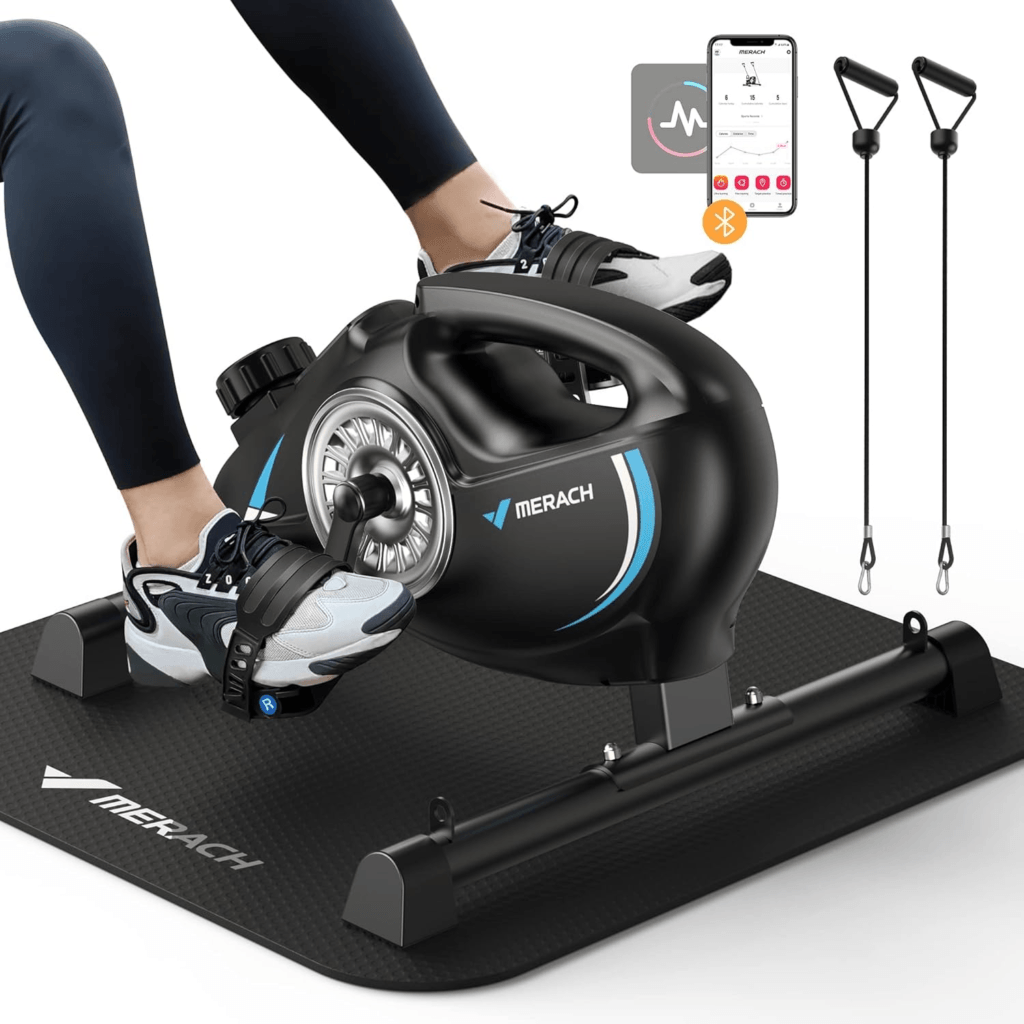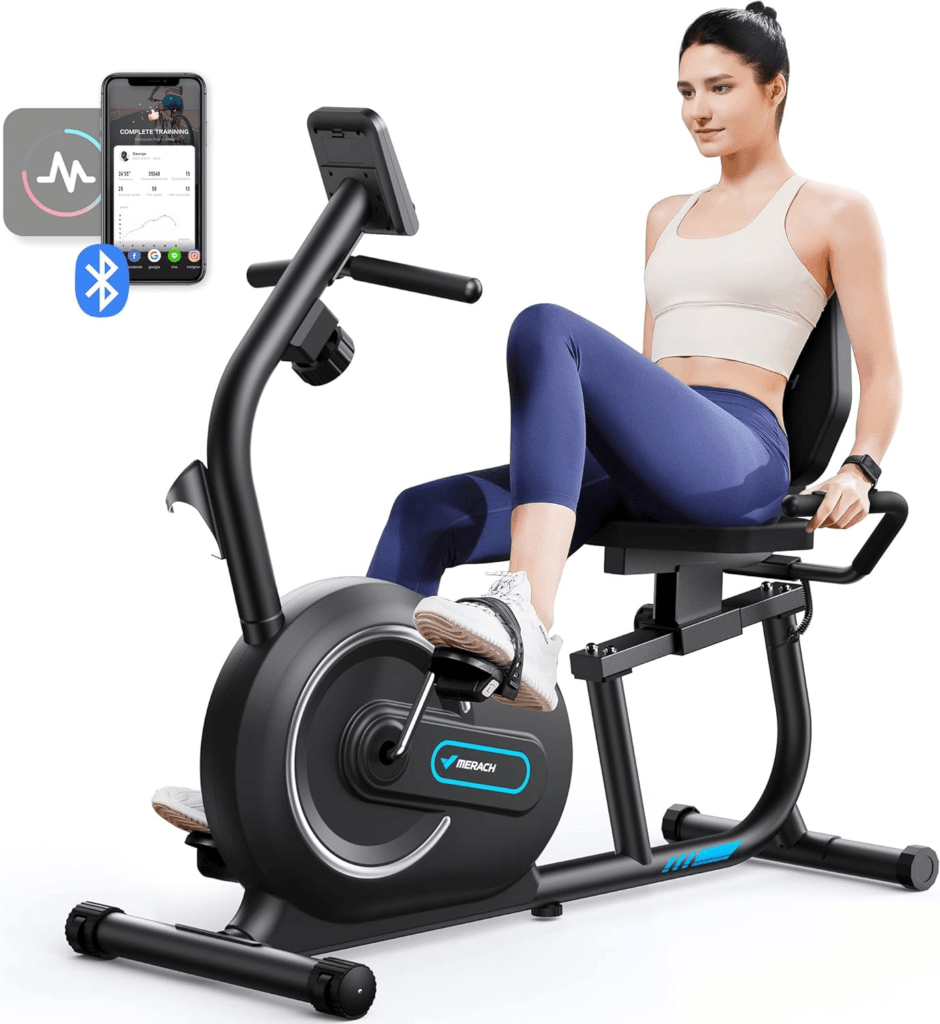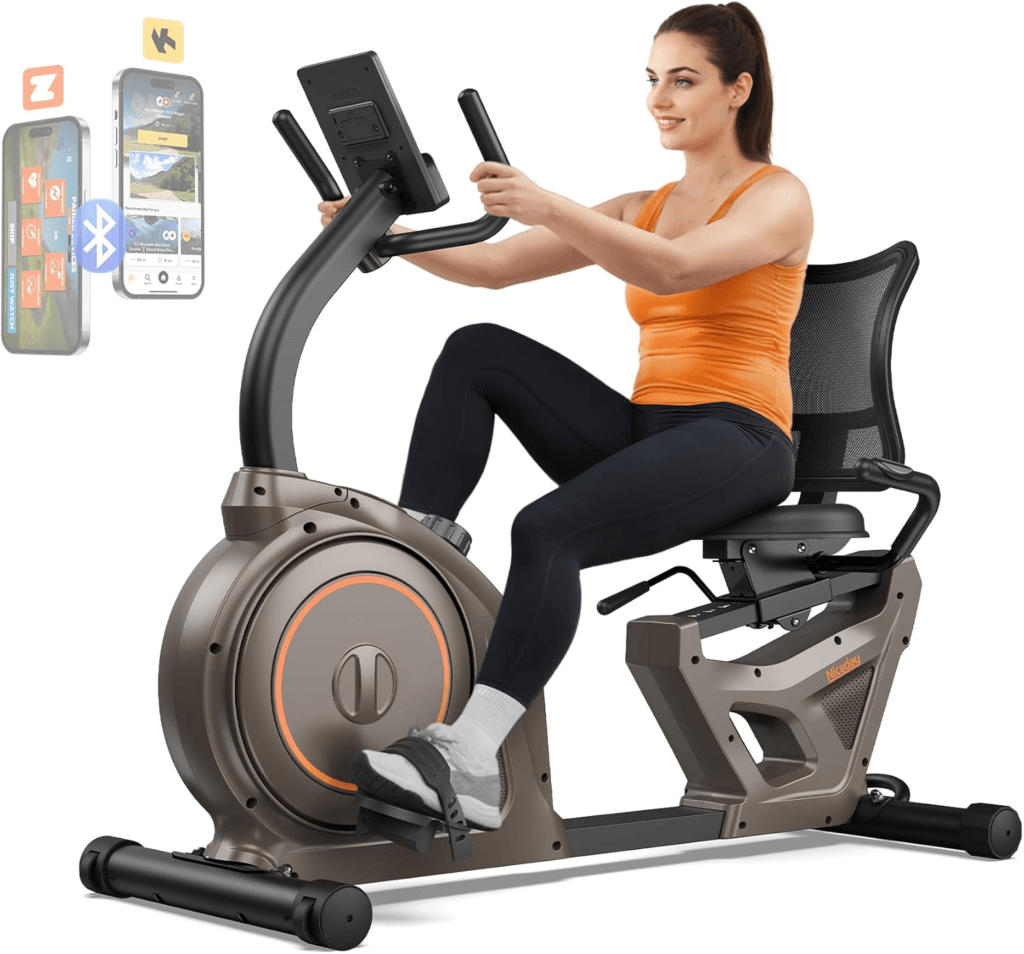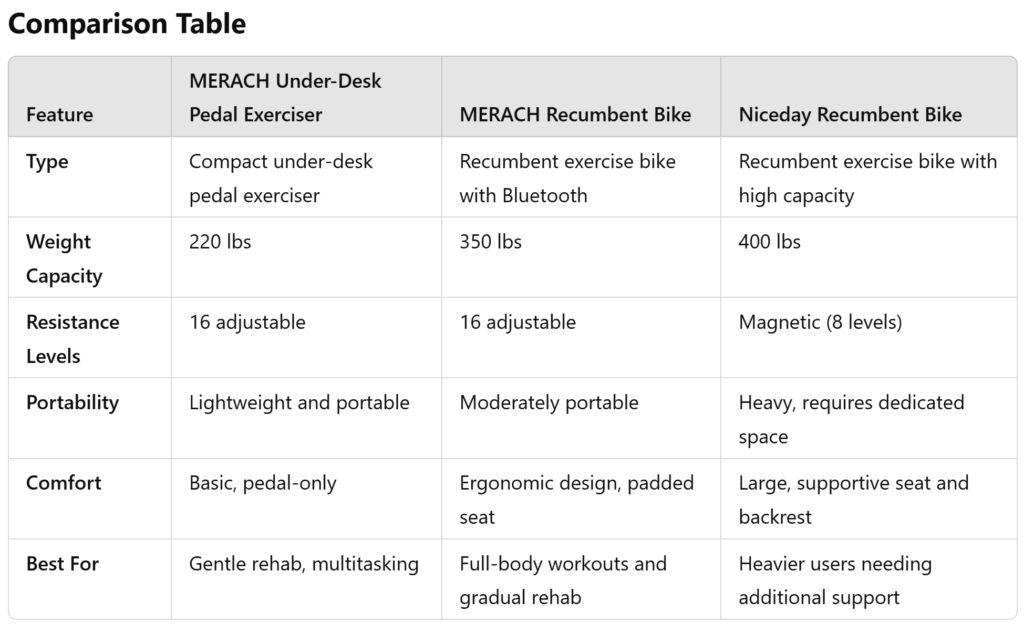Recovering from knee surgery can feel overwhelming, but the right tools can make all the difference. One of the best ways to regain strength and mobility is through low-impact exercises, and exercise bikes are a game-changer. Whether you’re looking for gentle rehab, a bit of cardio, or something sturdy to support your recovery, there’s a bike for you.
Today, we’re diving into three excellent options to help with knee surgery recovery: the MERACH Under-Desk Magnetic Pedal Exerciser, the MERACH Recumbent Exercise Bike, and the Niceday Recumbent Exercise Bike. Each of these bikes brings something unique to the table. Let’s explore their features, pros, cons, and benefits to help you make the best choice for your needs.
MERACH Under-Desk Magnetic Pedal Exerciser

If you need a compact and versatile solution for rehab exercises, the MERACH Under-Desk Pedal Exerciser is a great choice. This small, lightweight bike fits under a desk or table, making it perfect for gentle, low-impact recovery workouts.
What It Offers
- Smooth magnetic resistance with 16 adjustable levels.
- Portable design for easy storage and transport.
- Bluetooth connectivity to track workouts using the MERACH app.
Pros
- Compact and space-saving design.
- High resistance levels for progressive recovery.
- Easy app connectivity for tracking your progress.
Cons
- No built-in seat or handlebars.
- Best suited for lower-body exercises only.
Who It’s Best For
This bike is ideal for those who want a portable solution for gentle rehab exercises and don’t have room for a full-size exercise bike.
MERACH Recumbent Exercise Bike with Bluetooth Connectivity

For those who want to take their rehab a step further, the MERACH Recumbent Bike offers more advanced features. Its ergonomic design and app connectivity make it ideal for people who are progressing in their recovery and want to track their progress.
What It Offers
- A comfortable, supportive recumbent design.
- 16 resistance levels to grow with your recovery.
- Bluetooth connectivity for syncing with workout apps.
Pros
- The seat and backrest provide excellent comfort and support.
- You can track your workouts and set goals using the app.
- Adjustable resistance makes it suitable for different recovery stages.
Cons
- It’s bulkier than compact models like the under-desk exerciser.
- Requires more floor space.
Who It’s Best For
The MERACH bike is perfect if you want a more comprehensive workout experience with the ability to track your progress.
Niceday Recumbent Exercise Bike with High Weight Capacity

If stability and support are your top priorities, the Niceday Recumbent Bike has you covered. With its sturdy build and high weight capacity, it’s designed for people who need extra comfort and reassurance during their recovery.
What It Offers
- Supports up to 400 lbs, accommodating a wide range of users.
- Magnetic resistance for a smooth and quiet ride.
- A large, comfortable seat and backrest for added support.
Pros
- Exceptionally sturdy and durable.
- Comfortable design reduces strain during long workouts.
- Quiet operation, so it’s home-friendly.
Cons
- It’s the heaviest and least portable of the three.
- Takes up more space and is pricier than compact options.
Who It’s Best For
If you need extra support or stability during your recovery, the Niceday bike is a solid choice.

Recommendation
Each bike has its strengths, so the right choice depends on your specific needs:
- Best for Space and Simplicity: The MERACH Under-Desk Pedal Exerciser is ideal for those who need something portable and straightforward for gentle recovery.
- Best for Progress Tracking: The MERACH Recumbent Bike offers a balanced blend of functionality and comfort, especially if you enjoy tech-friendly features like app connectivity.
- Best for Stability and Comfort: The Niceday Recumbent Bike is unbeatable for those who prioritize extra support and durability.
Overall Recommendation: If you’re looking for versatility and comfort, the MERACH Recumbent Bike hits the sweet spot for most users.
Conclusion
Exercise bikes are a fantastic tool for knee surgery recovery, offering a safe and effective way to rebuild strength and flexibility. Whether you choose the compact MERACH Under-Desk Pedal Exerciser, the versatile MERACH Recumbent Bike, or the supportive Niceday Recumbent Bike, the key is consistency and listening to your body.
Remember, recovery is a journey, not a race. With the right tools and mindset, you’ll be back on your feet stronger than ever!
** Our website contains affiliate links. This means if you click and make a purchase, we may receive a small commission. Don’t worry, there’s no extra cost to you. It’s a simple way you can support our mission to bring you quality content.
FAQ
Are exercise bikes safe to use after knee surgery?
Yes! Exercise bikes are a safe and effective way to aid knee surgery recovery. They provide low-impact motion that strengthens the joint and improves flexibility. Always check with your doctor or physical therapist before starting.
When can I start using an exercise bike after knee surgery?
Most people can begin gentle pedaling exercises 2-3 weeks after surgery. However, the timeline varies depending on your recovery progress and your doctor’s advice.
Which type of exercise bike is best for knee recovery?
Recumbent bikes are often the best choice as they provide better support, reduce joint strain, and offer a comfortable position for your recovery journey.
Should I focus on motion or resistance?
Early in recovery, prioritize smooth motion to increase flexibility. As your knee heals, gradually introduce resistance to build strength.
How often should I use an exercise bike for recovery?
Start with 10-15 minutes a day at a low resistance level, then gradually increase time and intensity as you progress.

Your article on exercise bikes for knee surgery recovery is an excellent resource for anyone navigating their post-surgery journey. The thoughtful breakdown of each bike’s features, pros, and cons makes it easy for readers to identify the right option for their specific needs. You’ve done a great job highlighting the importance of choosing equipment that aligns with recovery goals, from gentle motion to stability and tracking progress.
I particularly appreciate the way you’ve categorized the bikes—whether it’s the compact MERACH Under-Desk Pedal Exerciser for those with limited space, the tech-friendly MERACH Recumbent Bike for progress tracking, or the supportive Niceday Recumbent Bike for those needing extra stability. Your recommendations feel tailored and practical, making it approachable for people at different recovery stages.
The inclusion of a detailed FAQ section is a standout feature. It addresses common concerns like safety, timing, and the focus between motion and resistance. This not only provides reassurance to readers but also sets realistic expectations for their recovery journey.
A quick question: For someone who’s transitioning from gentle rehab to more intensive workouts, do you have any tips on how to safely increase resistance and duration on these bikes without risking strain? It would be helpful to hear more about how to balance progression with caution during recovery.
Hi Alan,
Thank you so much for your kind words and detailed feedback on my article! I’m thrilled to hear that you found the breakdown of features, categories, and the FAQ section helpful—it means a lot to know the content is making a difference for those navigating their recovery journey.
To address your question about safely transitioning from gentle rehab to more intensive workouts on these exercise bikes, here are a few tips:
1. Gradual Resistance Increase: Start by increasing resistance in small increments. Most bikes have resistance levels, so move up just one level at a time and monitor how your knee responds during and after the workout.
2. Shorter Sessions at Higher Intensity: Before extending your workout duration, test how your knee handles a slightly higher intensity for a shorter time. For instance, if you’re currently biking for 20 minutes, try maintaining your usual resistance for 15 minutes and increasing it for the last 5.
3. Focus on Warm-Ups and Cool-Downs: Ensure you’re warming up adequately to prepare your knee for more effort. A 5–10-minute gentle pedal at low resistance before starting your main session helps. Similarly, cool down after each session to ease recovery.
4. Listen to Your Body: Pay attention to any signs of discomfort or strain. Mild soreness is normal as you progress, but sharp pain or swelling should prompt a step back in intensity.
5. Add Variety: Alternate between resistance and duration-focused sessions. For example, one day, work on longer, steady-state rides, and the next, focus on shorter sessions with slightly more resistance.
6. Check with Your Physical Therapist: If possible, consult your PT for tailored advice. They can recommend adjustments based on your specific recovery phase and goals.
I hope these tips are helpful! Feel free to reach out with any more questions—I’d be happy to assist further. Wishing you all the best on your recovery journey!
Cheers
John
Having a knee injury can be very debilitating, specially if you then need surgery. Using an exercise bike to help you with your rehab, is a great way of building muscle strength, but without putting additional weight onto the knee.
The Merach under the desk pedal exerciser seems like a great choice that won’t take up too much space. And of course,one can use it while watching television as well. But would it also be suitable for those that have a knee replacement? Or is there a specific model for those with knee replacements? Thank you.
Hi LineCowley,
Thank you for your thoughtful comment! You’re absolutely right—exercise bikes are excellent for rebuilding muscle strength post-surgery while keeping stress on the knee minimal. The Merach under-desk pedal exerciser is indeed a space-saving and convenient option, especially for multitasking during recovery. 😊
Regarding its suitability for knee replacement recovery, it can work well for many individuals because of its low-impact nature and adjustable resistance. However, it’s essential to ensure the range of motion is comfortable and doesn’t cause strain.
For those recovering from a knee replacement, a recumbent bike is often recommended because it provides more support and stability. Models with adjustable pedals, low resistance levels, and a smooth pedaling motion are ideal.
I’d suggest consulting a physical therapist to ensure the device suits your specific recovery needs. Have you tried the Merach, or are you considering adding it to your routine?
Cheers
John
This is a great guide for those looking to aid their recovery post-surgery. It reviews various bikes, focusing on features that support low-impact exercise, which is crucial for rehabilitation.
From my experience, using a recumbent bike after my knee surgery was incredibly beneficial, as it provided comfort while allowing me to gently regain strength. The adjustable resistance and seat comfort were particularly helpful.
What specific features do you think are most important when choosing an exercise bike for recovery? Or is it as long they are low impact, it can help
Hi Nikki,
Thank you for sharing your experience and kind words! 😊 I completely agree—recumbent bikes can be a fantastic option for post-surgery recovery, offering both comfort and support for low-impact exercise. Adjustable resistance and seat comfort are indeed crucial features, as they allow for gradual progress and minimize strain on the knee.
When choosing an exercise bike for recovery, I believe these features are key:
Adjustable Resistance Levels: To cater to different stages of recovery.Seat Comfort & Adjustability: Ensures proper posture and reduces pressure on the knee joint.Low Step-Through Design: Makes it easier to get on and off, especially if mobility is limited.Smooth Pedaling Motion: Reduces stress on the knees.Clear Display for Monitoring Progress: Encourages motivation and tracks recovery milestones.
While low-impact is the foundation, a combination of these features ensures a more tailored and effective recovery experience. What other features did you find helpful in your recovery journey?
Cheers
John